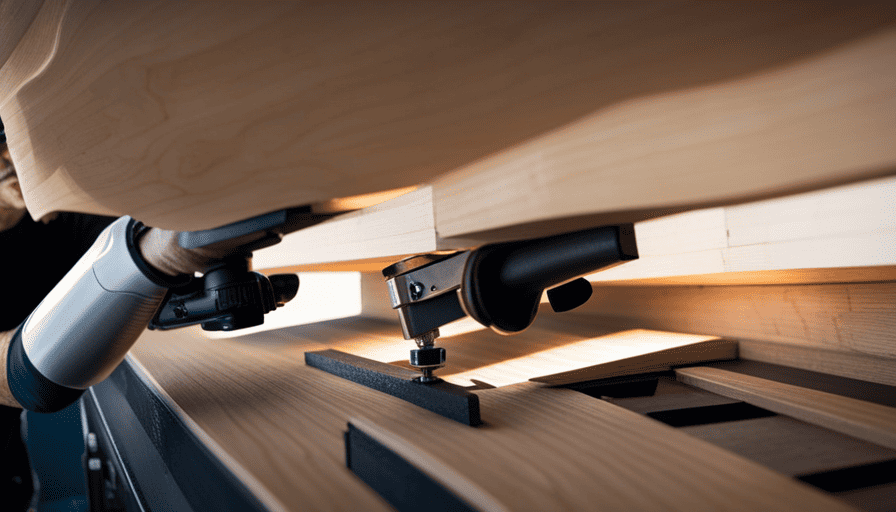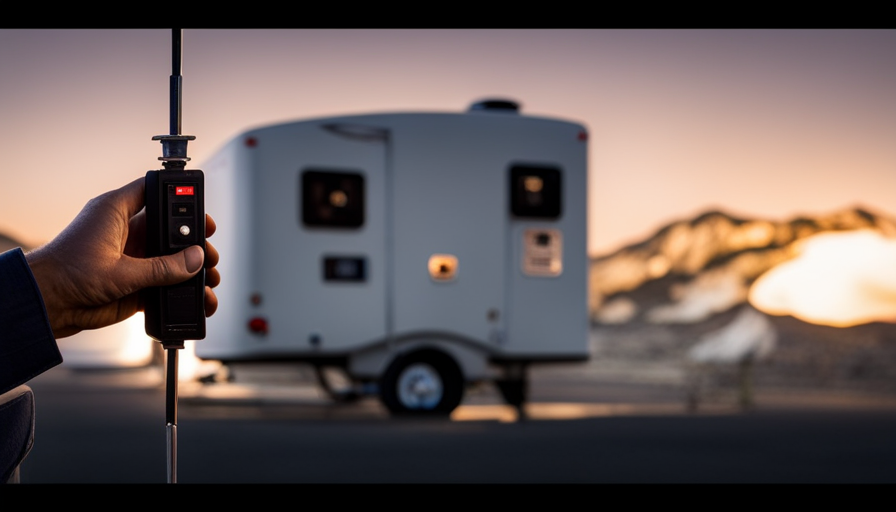The saying “Home is where you park it” rings true for those who have embraced a nomadic lifestyle, with our camper trailers serving as our cozy homes on wheels. However, as we travel through different climates and experience fluctuating temperatures, it is important to focus on proper insulation in our mobile dwellings.
So, if you’re ready to embark on the journey of insulating your camper trailer, look no further. In this article, I will guide you through the process step by step, drawing from my years of experience as a seasoned camper. From assessing your insulation needs to choosing the right materials and tackling every nook and cranny, I’ll share all the tips and tricks you need to create a snug and comfortable home on the road.
So, grab your toolbox and let’s get started on transforming your camper trailer into a cozy oasis that will keep you warm in winter and cool in summer, no matter where your wanderlust takes you.
Key Takeaways
- Assess current insulation needs by examining walls, ceiling, and flooring
- Choose the right insulation material based on climate conditions, cost, ease of installation, R-value, and moisture resistance
- Insulate floors, walls, ceiling, windows, and roof for optimal insulation
- Regularly inspect, maintain, and repair insulation for longevity and effectiveness
Assess Your Current Insulation Needs
You’ll need to first assess your current insulation needs to determine the best way to insulate your camper trailer. Assessing insulation requirements involves evaluating the current insulation in your camper trailer and identifying any gaps or areas that may need improvement.
Start by examining the walls, ceiling, and flooring to see if there are any visible signs of insulation damage or wear. Look for cracks, holes, or gaps where air can escape or enter. Additionally, consider the climate conditions you typically encounter while camping, as this will impact the type and amount of insulation needed.
Once you have assessed your insulation requirements, you can move on to selecting the appropriate insulation material. There are various options available, including fiberglass, foam, and reflective insulation. Fiberglass insulation is a popular choice due to its affordability and effectiveness in reducing heat transfer. Foam insulation provides excellent insulation properties and can be easily applied to irregular-shaped areas. Reflective insulation is ideal for campers in hot climates as it reflects heat away from the interior. Consider factors such as cost, ease of installation, and insulation R-value when choosing the right insulation material.
Now that you have assessed your insulation needs and chosen the appropriate insulation material, it’s time to learn how to properly install the insulation in your camper trailer.
Choose the Right Insulation Material
When choosing the right insulation material for your camper trailer, it’s essential to consider factors such as R-Value and moisture resistance. The R-Value indicates how well the insulation can resist heat transfer, with a higher value indicating better insulation.
Additionally, it’s crucial to compare different types of insulation materials, such as fiberglass, foam board, or spray foam, to determine which one best suits your specific needs.
Consider Factors such as R-Value and Moisture Resistance
To effectively insulate your camper trailer, it’s crucial to take into account factors such as the R-value and moisture resistance. This ensures maximum energy efficiency and protection against condensation.
The R-value calculation is a measure of an insulation material’s thermal resistance, indicating how well it can resist heat flow. The higher the R-value, the better the insulation.
Additionally, it’s important to consider moisture resistance to prevent water damage and mold growth. This can be achieved by incorporating vapor barriers, which prevent moisture from seeping into the insulation.
By carefully considering the R-value and moisture resistance of your insulation material, you can create a comfortable and energy-efficient living space in your camper trailer.
Now, let’s move on to comparing different types of insulation materials.
Compare Different Types of Insulation Materials
Comparing various insulation materials can provide valuable insight into choosing the most effective option for creating a well-insulated and comfortable living space in your mobile home. When comparing insulation materials, it is important to consider their R-value, which measures their thermal resistance. The higher the R-value, the better the insulation. Additionally, moisture resistance is crucial to prevent mold and damage to the structure. To help you make an informed decision, I have created a table that compares four commonly used insulation materials: fiberglass, foam board, spray foam, and reflective insulation.
| Insulation Material | R-Value per inch | Moisture Resistance | Energy Efficiency |
|---|---|---|---|
| Fiberglass | 3.14-4.3 | Low | High |
| Foam Board | 4-7 | High | High |
| Spray Foam | 3.5-6.5 | High | Very high |
| Reflective Insulation | 3.5-6 | Low | High |
Considering the insulation materials comparison and energy efficiency factors, you can now move on to insulating the floors and walls of your camper trailer to further improve its comfort and energy efficiency.
Insulate the Floors and Walls
Now imagine cozying up in your camper trailer, feeling like you’re wrapped in a warm, protective cocoon as the insulated floors and walls keep the chilly air at bay.
When it comes to insulating your camper, it’s crucial to assess the temperature variations you’ll encounter on your travels. This will help you determine the type and thickness of insulation needed to maintain a comfortable interior climate.
Insulating the floors and walls is an essential step in creating a well-insulated camper. Start by choosing insulation materials that have a high R-value, such as foam boards or fiberglass batts. These materials effectively trap heat and keep cold air from seeping in. It’s important to thoroughly insulate the entire floor and walls, ensuring there are no gaps or spaces for air to escape.
Additionally, don’t forget to insulate the ceiling, as heat can easily escape through this area. By insulating the floors, walls, and ceiling, you’ll create a barrier against outside temperature fluctuations, making your camper cozy and energy-efficient.
Now, let’s move on to another important aspect of camper insulation: the windows.
Insulate the Windows
Imagine how much cozier your camper will feel once you’ve properly sealed and insulated the windows, allowing you to enjoy the beautiful views outside while keeping the cold air out. Insulating the windows of your camper is crucial for maintaining a comfortable temperature inside, especially during extreme weather conditions. There are a few effective methods to insulate the windows, such as using thermal curtains and double glazing.
Thermal curtains are an excellent option for insulating your camper windows. These curtains are designed with special materials that have insulating properties to prevent heat loss or gain. They provide an extra layer of insulation, helping to keep the cold air outside and the warm air inside. Additionally, thermal curtains also block out sunlight, which can help regulate the temperature inside your camper during hot summer days.
Another option to consider is double glazing. Double glazing involves installing a second layer of glass on your camper windows. The space between the two layers of glass acts as an additional insulation barrier, reducing heat transfer and preventing drafts. This method is particularly effective in cold climates, as it provides an extra layer of protection against the cold air outside.
By properly insulating your camper windows with thermal curtains or double glazing, you can significantly improve the overall insulation of your camper. This will not only make it more comfortable during your travels but also help to reduce energy consumption. Now, let’s move on to the next step and discuss how to insulate the roof of your camper…
Insulate the Roof
To make your camping experience more comfortable, consider insulating the roof of your vehicle. Studies show that proper roof insulation can reduce heat loss by up to 70%. Roof insulation offers several benefits that will enhance your camper trailer experience.
Firstly, it helps to regulate the temperature inside the vehicle, keeping it cooler in hot weather and warmer in cold weather. This allows you to enjoy a comfortable environment no matter the outside conditions.
Secondly, roof insulation also helps to reduce noise from rain, wind, and other external sources, creating a quieter and more peaceful atmosphere inside the camper.
Lastly, it provides an additional layer of protection against condensation and moisture buildup, preventing damage to the interior of your vehicle.
When installing roof insulation, there are a few tips to keep in mind. First, choose the right type of insulation material that suits your needs and budget. Common options include foam boards, fiberglass batts, and reflective foils.
Next, ensure that the insulation is properly fitted and covers the entire roof surface, including any gaps or seams. This will maximize its effectiveness and prevent any heat loss.
Lastly, consider adding a vapor barrier to further protect against moisture.
By insulating the roof of your camper trailer, you can significantly improve its comfort and energy efficiency. Once the roof insulation is in place, it’s important to seal any air leaks to maximize its effectiveness.
Seal Any Air Leaks
When it comes to sealing any air leaks in a camper trailer, there are a few key points to keep in mind. First, it’s important to use weatherstripping or caulking to seal any gaps or cracks in the trailer’s exterior. This will help prevent air from entering or escaping, keeping the interior comfortable.
Additionally, it’s crucial to inspect and repair any damaged seals or vent covers, as these can be common sources of air leaks. By addressing these issues, you can ensure that your camper trailer is properly sealed and ready for any adventure.
Use Weatherstripping or Caulking to Seal Gaps
First, make sure to use weatherstripping or caulking to seal any gaps in your camper trailer, preventing any drafts or leaks. This step is crucial in insulating your trailer effectively and maintaining a comfortable interior temperature.
One option to consider is using foam tape, which provides additional insulation and helps seal any small gaps. It’s also worth exploring alternative sealing methods, such as using silicone caulking or adhesive-backed weatherstripping, depending on the specific gaps you need to seal. These options can be found at most hardware stores and are relatively easy to apply.
By properly sealing the gaps in your camper trailer, you can minimize heat loss in the winter and keep cool air in during the summer. This will create a more energy-efficient and comfortable living space.
Moving on to the next step, it’s important to inspect and repair any damaged seals or vent covers to further enhance the insulation of your trailer.
Inspect and Repair any Damaged Seals or Vent Covers
Ensuring the integrity of your seals and vent covers is like fortifying the armor of your mobile sanctuary. It’s crucial to regularly inspect these components for any signs of damage or wear.
Here are three key aspects to consider when inspecting and repairing damaged seals and vent covers:
-
Thoroughly examine all seals for cracks, gaps, or tears. Pay close attention to areas around windows, doors, and utility connections. Replace any damaged seals promptly to prevent air and moisture leakage.
-
Inspect vent covers for signs of deterioration, such as rust or loose screws. Damaged vent covers can compromise the insulation of your camper trailer and allow unwanted elements to enter. Replace or repair these covers as needed.
-
Don’t forget to check for proper alignment and tightness of all seals and vent covers. Ensure they’re securely fastened and provide a snug fit to prevent any potential drafts or leaks.
By diligently inspecting and repairing damaged seals and vent covers, you can enhance the insulation of your camper trailer. This’ll create a more comfortable and energy-efficient living space.
Now, let’s move on to the next section about installing insulated skirting or skirt panels.
Install Insulated Skirting or Skirt Panels
To maximize coziness and keep those chilly drafts at bay, you’ll want to get started by installing insulated skirting or skirt panels for your camper trailer. Insulated skirting is a fantastic addition to any camper trailer, as it provides numerous benefits. Not only does it help to regulate the temperature inside the trailer, but it also adds an extra layer of protection against the elements.
One of the main advantages of insulated skirt installation is that it helps to prevent heat loss. By creating a barrier around the bottom of the trailer, insulated skirting traps the heat inside, keeping the interior warmer during colder months. It also helps to keep cold air out, reducing drafts and making the space more comfortable.
In addition to the temperature regulation benefits, insulated skirting also helps to protect the trailer’s plumbing and undercarriage from freezing temperatures. By providing an extra layer of insulation, it prevents pipes from freezing and potentially bursting, saving you from costly repairs.
To give you a better idea of the benefits of insulated skirting, take a look at the table below:
| Benefits of Insulated Skirting |
|---|
| Regulates temperature inside |
| Reduces drafts and cold air |
| Protects plumbing and undercarriage |
By installing insulated skirting or skirt panels, you can greatly improve the comfort and energy efficiency of your camper trailer. Now that your trailer is properly insulated, let’s consider auxiliary heating options to ensure maximum coziness during those chilly nights.
Consider Auxiliary Heating Options
Now that you’ve got your cozy insulated skirting in place, let’s explore some auxiliary heating options to make your camper feel like a toasty winter paradise.
When it comes to heating options for your camper, it’s essential to consider both effectiveness and energy efficiency. One option is to install a propane furnace, which can provide a reliable and powerful heat source. These furnaces are designed specifically for RVs and are highly efficient, allowing you to keep your camper warm without wasting energy.
Another option is to use electric space heaters, which are portable and easy to use. Look for energy-efficient models with adjustable thermostats and built-in safety features.
Additionally, you can consider installing a heat pump, which can both heat and cool your camper. Heat pumps are energy-efficient and can provide consistent heating throughout your camper.
As you explore these heating options, remember to prioritize energy efficiency to minimize your environmental impact and reduce heating costs.
Now, let’s dive into the next section and discuss how to insulate the plumbing system, ensuring your camper stays warm and functional even in the coldest temperatures.
Insulate the Plumbing System
When it comes to insulating the plumbing system in a camper trailer, there are a few key points to consider.
First and foremost, it’s crucial to use pipe insulation to prevent freezing during colder weather. This will help ensure that the water supply remains intact and functional.
Additionally, installing insulated holding tanks or using heat tape can provide an extra layer of protection against freezing temperatures. This ensures that the plumbing system remains in good working condition.
Use Pipe Insulation to Prevent Freezing
Ensure your camper trailer stays cozy and protected during chilly winter adventures by using pipe insulation to prevent freezing. Here are four key tips for preventing freezing with pipe insulation:
-
Choose the right insulation: Opt for foam pipe insulation, as it provides excellent insulation and is easy to install.
-
Measure accurately: Measure the diameter and length of your pipes to ensure you purchase the correct size of insulation.
-
Install properly: Cut the insulation to fit the length of the pipe and secure it with zip ties or tape. Be sure to cover all exposed areas, including bends and joints.
-
Check for gaps: Inspect the insulation regularly to ensure there are no gaps or areas where cold air could seep in.
By properly installing pipe insulation, you can effectively protect your plumbing system from freezing temperatures.
Now, let’s discuss how to install insulated holding tanks or heat tape for additional protection.
Install Insulated Holding Tanks or Heat Tape
To keep your camper trailer protected during chilly winter adventures, make sure you install insulated holding tanks or use heat tape. Insulated holding tanks are a great option as they provide an extra layer of protection against freezing temperatures. They’re designed with thick walls and added insulation to minimize heat loss and prevent your tanks from freezing.
However, they can be expensive and require professional installation. On the other hand, heat tape is a more affordable option that can be easily installed by wrapping it around your tanks and connecting it to a power source. It works by providing a constant source of heat to prevent freezing. However, it’s important to regularly inspect and maintain the heat tape to ensure it’s functioning properly.
Transitioning into the next section, regularly maintaining and inspecting your insulation is crucial to ensure its effectiveness in keeping your camper trailer warm and protected.
Regularly Maintain and Inspect Your Insulation
Make sure you keep a close eye on your insulation in order to prevent any unwanted surprises down the road. Regular maintenance of your camper trailer’s insulation is essential to ensure its effectiveness and longevity. By following a few simple tips, you can avoid common insulation problems and keep your trailer comfortable all year round.
Firstly, inspect your insulation regularly for any signs of damage or wear. Look for holes, gaps, or sagging areas that may compromise its efficiency. If you notice any issues, promptly repair or replace the affected insulation to maintain its effectiveness.
Additionally, make sure to clean your insulation on a regular basis. Dust, dirt, and debris can accumulate on the surface, reducing its ability to insulate properly. Use a soft brush or vacuum cleaner to remove any dirt or particles, being careful not to damage the insulation in the process.
Furthermore, consider adding an extra layer of insulation if needed. This can be done by using reflective foil, foam panels, or insulating blankets. These additional layers will enhance the insulation properties of your camper trailer, especially in extreme temperatures.
Lastly, pay attention to the seals and weatherstripping around doors, windows, and vents. Over time, these can deteriorate, allowing drafts and heat loss. Inspect them regularly and replace any damaged seals to maintain a tight seal and optimize insulation efficiency.
By following these regular maintenance tips and addressing common insulation problems, you can ensure that your camper trailer remains well-insulated and comfortable no matter the weather conditions.
Frequently Asked Questions
How much does it cost to insulate a camper trailer?
The cost of insulating a camper trailer can vary depending on several factors. DIY insulation projects are generally more cost-effective, as you can purchase materials and do the work yourself. However, professional insulation services provide expertise and may be necessary for complex installations.
The cost factors include the size of the trailer, the type of insulation material used, and any additional modifications required. It’s important to consider your budget and the level of insulation needed for optimal comfort and energy efficiency.
Can I use the same insulation material for both the floors and walls?
Yes, you can use the same insulation material for both the floors and walls of your camper trailer. When it comes to insulation material comparison, it’s important to consider factors such as R-value, moisture resistance, and ease of installation. I recommend using a rigid foam insulation board, as it provides excellent insulation and is easy to cut and install.
Additionally, make sure to properly seal any gaps or seams to prevent air leakage and maximize the effectiveness of the insulation.
What are the best methods to insulate windows in a camper trailer?
When it comes to insulating windows in a camper trailer, the best insulation materials are window insulation film and thermal curtains. These options are cost-effective and easy to install yourself.
Window insulation film creates a barrier that traps air and reduces heat transfer. Thermal curtains have an insulating lining that helps regulate temperature.
While professional window insulation services exist, DIY methods are more budget-friendly and can be just as effective with the right materials and techniques.
Is it necessary to insulate the roof of a camper trailer?
Insulating the roof of a camper trailer isn’t mandatory, but it offers several advantages. One option for roof insulation is using foam board insulation, which provides excellent heat resistance. This helps regulate the temperature inside the trailer, keeping it comfortable in extreme weather conditions. However, roof insulation can add extra weight and reduce headroom. It’s important to carefully consider the benefits and drawbacks before deciding whether to insulate the roof of a camper trailer.
How often should I inspect and maintain the insulation in my camper trailer?
I recommend inspecting and maintaining the insulation in your camper trailer at least once a year. This will ensure that it remains in good condition and continues to provide effective insulation.
Regular inspections can help identify any issues such as wear and tear, moisture damage, or pests that may affect the insulation’s performance. If any repairs or replacements are needed, the cost of insulating a camper trailer can vary depending on the materials used, but there are affordable options available such as foam board or reflective insulation.
Can Insulating My Camper Trailer Help Increase Its Value Before Selling?
When it comes to getting rid of old camper trailers, many sellers wonder how they can increase the value of their vehicle before selling. One effective way to do so is by insulating the camper trailer. By insulating it, potential buyers will see the added value in terms of improved energy efficiency and better temperature control. Ultimately, this can make your camper trailer more appealing and potentially increase its selling price.
Conclusion
In conclusion, insulating a camper trailer is a crucial step towards creating a comfortable and energy-efficient living space on the road. By assessing your insulation needs and selecting the right materials, you can transform your camper into a cozy sanctuary.
Insulating the floors, walls, windows, and roof will ensure maximum thermal efficiency, while adding insulated skirting or skirt panels will further enhance insulation.
Don’t forget to consider auxiliary heating options and insulate the plumbing system for year-round comfort. Regular maintenance and inspections will keep your insulation in optimal condition.
Just like a warm hug on a chilly day, proper insulation will embrace you with comfort and peace of mind during your travels.



















